A machine gun in a tin can. Shelf Containers from Springfield Arsenal
In 1945, the American command reasonably decided that in the future the reduced army would not need most of the available small arms, and this property should not be taken up in warehouses. On the other hand, everyone was waiting for the start of a new war, and weapons could be needed at any time. In this regard, the Springfield arsenal received a special task. He had to develop a new method of long-term storage of temporarily unnecessary small arms. This method was supposed to ensure the storage of weapons without any service, but with the possibility of its quicker return to service.
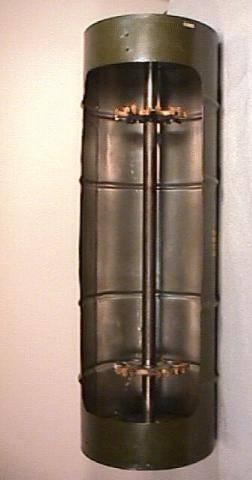
Rifle container
The task was solved in 1946-47. Arsenal has developed special metal containers suitable for storing several weapons. At its core, these were the usual larger-sized cans. Due to the different internal equipment such containers could be used with weapons of all basic types. Containers and inner inserts had the simplest design, however, their preparation for storage differed a certain complexity. But the implementation of all instructions allowed to store weapons for many years.
Container and its contents
The container from the Springfield arsenal was a metal barrel of predetermined dimensions. Thus, the container for the M1 Garand rifles was 47 inches high (1,2 m) and 15,875 inch diameter (403 mm). Less high “cans” were intended for pistols, and it was proposed to store machine guns in long and narrow containers.
The cylindrical wall of the container was made by stamping metal sheet and welded along the joint; it had transverse stiffeners. On the ends provided covers for the covers. The covers were also stamped and had to be welded to the wall. New products were proposed to be made of steel or aluminum sheet. Aluminum containers were designed for large-caliber machine guns, steel - for other weapons.
Inside the container should install a holding device for weapons. There were several types of such devices designed for different "cargo". The simplest was a device for rifles or carbines. It consisted of two metal discs connected by a vertical bar. On the latter two curved holders were fixed with slots for mounting weapons. Such a holding device was also complemented by several straps covering the outside load.
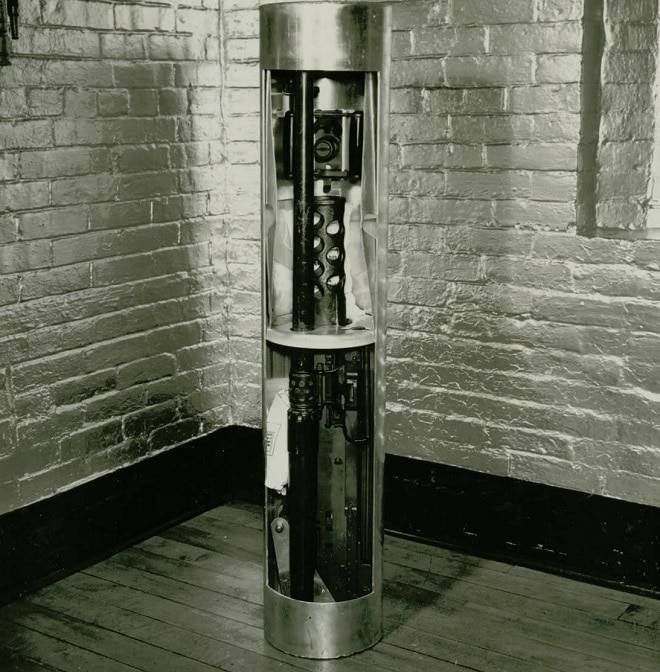
Split container layout with M2 machine gun
A device of this type could be used with M1 Garand rifles and M1 Carbine family products, as well as with M1918 automatic rifles. Self-loading rifles and carbines, distinguished by a small section, were placed in a container in the amount of ten pieces. Half was mounted on the holders vertically with the barrel upwards, another five units were muzzled down. Then they were covered with a pair of belts. Larger BAR rifles were stored in five pieces, all in one position. Together with the weapon in the containers should be placed all the necessary supplies.
Large machine gun M2, for obvious reasons, completely occupied one container. Before packing, it was necessary to remove the barrel, after which the disassembled weapon was fixed in a special holding system on the basis of clips. Machine gun, if available, was stored separately.
An interesting holding device was developed for storing M1911 pistols. In this case, 10 stamped disks consistently fit inside the container, each of which had a figured lodgment for two pistols and two stores (two more were in the arms of the weapon). Pistols and shops were placed as close as possible and fit into the container section. The container for the Colts contained 10 drives: 20 pistols and 40 stores. The empty space in the center of the container, between the pistols, could be occupied by various accessories.
For opening containers developed a special device. The unit weighing almost 14 kg was an enlarged version of a household can opener with a rotating wheel. Used manual transmission with transmission on two rotating wheels. The strength of the knife was sufficient for cutting the lids of the containers. "Opener" could be used in a portable form or be installed on any platform.
Preservation process
Before conservation, small arms should be cleaned with any approved solvent. Then it was required to cover it with AXS-1759 anti-corrosion compound. The anti-corrosion film made it possible to protect metal parts, as well as to simplify and speed up the re-entry process. After that, the weapon should be covered with a preservative grease.
The prepared weapon was mounted on holders and, if necessary, secured with straps. Also on the restraints were fixed stores, regular belts for carrying and other accessories. Metal cans with several pounds of silica gel, designed to remove moisture from the air, were also placed in a container and rigidly attached. The holding device with the weapon was placed in the container in the required position and practically without gaps. The movement of the device and weapons was excluded for the safety of the contents.
Then, in its place with the help of oxy-acetylene welding, the top cover was fixed. After installing the cover checked tightness. For this, the container was placed in water with a temperature of 180 ° F (82 ° C). Hot water forced the air in the container to expand and create excess pressure. Poor welding manifested itself bubbles. If necessary, the container was boiled again.
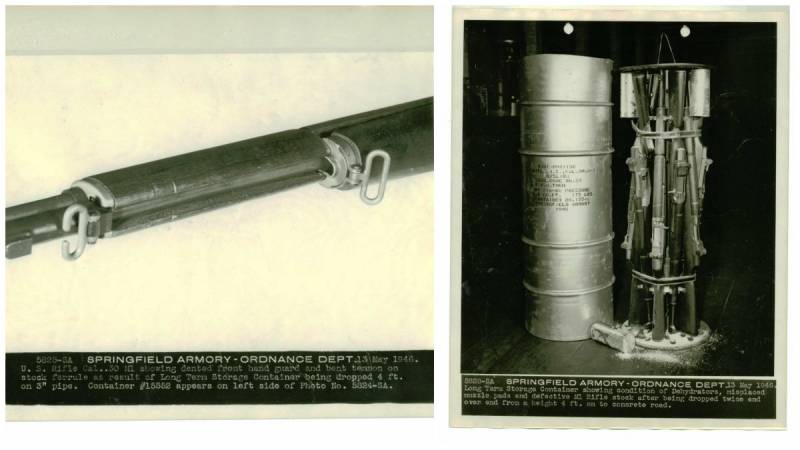
The result of testing one of the containers. A can of silica is ripped off (right), one of the rifles is damaged.
Then painting was carried out, also intended to protect the container and weapons. The surface of the container was degreased with steam, then phosphated and dried. After that, the steel containers were painted. They were applied two layers of enamel color "olive". Each layer was baked with infrared lamps for 5 minutes, after which 10-minute cooling was performed. This mode of heating and cooling allowed to exclude overheating of the contents and the creation of pressure that can break through the welds. Aluminum containers remained unpainted. Upon completion of processing on the side surface, stencils were applied with information about the contents, place and date of packaging, etc.
Tests and series
In 1947, the Springfield Arsenal produced an experimental batch of containers designed for extensive testing. Products with internal inserts for different weapons were checked. The containers were tested with rifles, pistols and machine guns, which made it possible to study their properties in all conditions.
The filled containers were shaken imitating loading and unloading. They were dropped from a height of 4 feet (1,2 m) at different angles on different surfaces, and also subjected to other external influences. The containers were also placed in a pressure chamber and the pressure was lowered, simulating the transportation of a military transport aircraft in an unpressurized cabin. After such bullying, the containers carried multiple chips and dents, but remained airtight.
Having opened the "barrels", the testers discovered a whole and efficient weapon. Only in one container did a metal can of silica gel fall from the bindings and crush the wooden parts of the rifles. According to the results of such inspections, containers of the Springfield Arsenal were recommended for production and operation.
Conservation of weapons using new tools began in the same year 1947 and lasted several years. The army planned to send for storage several hundred thousand weapons, and this required a lot of time. The necessary work was carried out by all major US arsenals. According to known data, in 1948, the 87,3 of thousands of M1 Garand rifles were conserved in 1949, and more than 220 of thousands of such items were put into containers in XNUMX, not counting weapons of other models.
Containers with weapons distributed among various military warehouses. Usually they were stored by the same compounds that were to use weapons in the event of war.
In the spring of 1959, the Springfield Arsenal opened several containers with different weapons to check the status of the latter. The weapon stayed in the 12 packaging for years, and after that it was possible to draw conclusions about the real possibilities of the original method of storage. It turned out that all samples retain good condition and after a short preparation can return to the service. The weapon had no mechanical damage, there was no rust or mold on it. It is curious that several Arsenal employees who participated in the opening and inspection of containers in the past contributed to their development or preparation for storage.
From storage to disposal
According to different sources, the containers of the Springfield Arsenal have been used for several decades. After that, they were abandoned for the most banal reasons. The army was gradually removing obsolete models like the M1 Garand and M1 Carbine. In parallel, various deliveries of weapons from stock to warehouses were carried out. Pistols, rifles and machine guns were removed from containers and sent abroad, to museums, to the civilian market or to the smelter.
At a minimum, the vast majority of containers after opening were disposed of as unnecessary, often together with the contents. Several such items have survived and are now on display at the American Museum. First of all, the containers are at the museum at the Springfield arsenal. According to various estimates, individual containers may still remain in army warehouses, but such assumptions appear to be untrue.
Apparently, a number of containers could get into private collections, but only in the opened form. According to American law, a container of weapons can not be completely sold to a private person. It is necessary to prepare documents for each unit, for which the container should be opened. Naturally, this dramatically reduces its collection value.
The original solution using sealed metal containers was proposed due to a sharp reduction in the army and its active arsenals. Over time, the US armed forces got rid of the surplus military products accumulated as a result of the Second World War, and new arsenals were formed in accordance with current requirements. The need for special long-term storage containers disappeared. Over the past few decades, the US Army has been using sealed containers only for storing ammunition, while weapons are being sold with more traditional closures. "Tin cans" for small arms are a thing of the past.
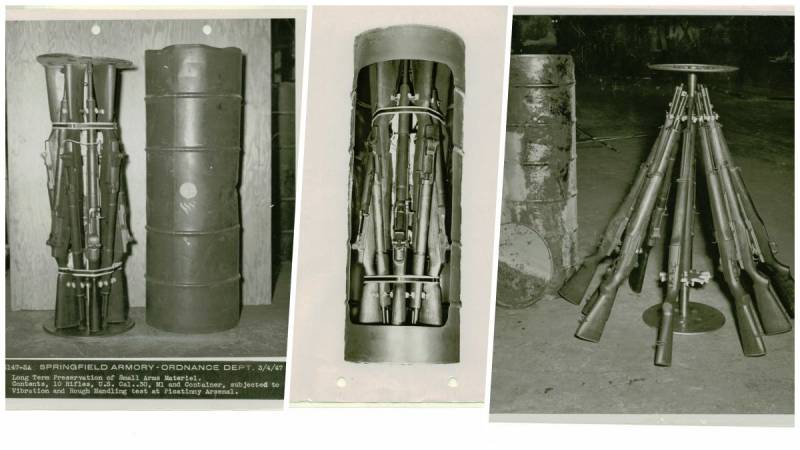
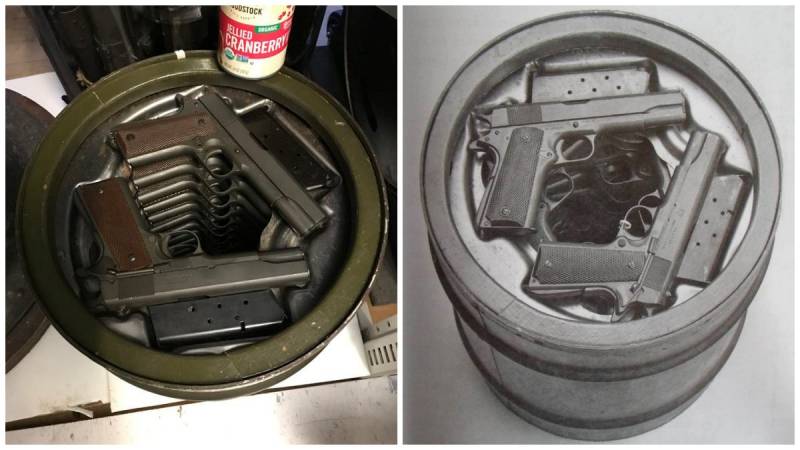
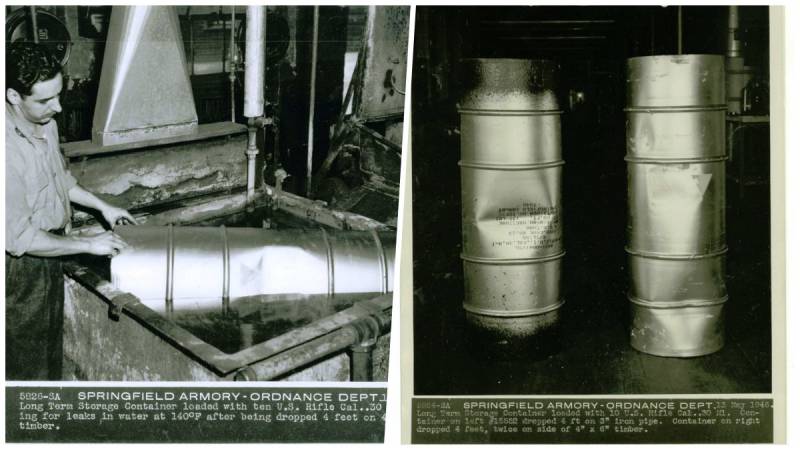
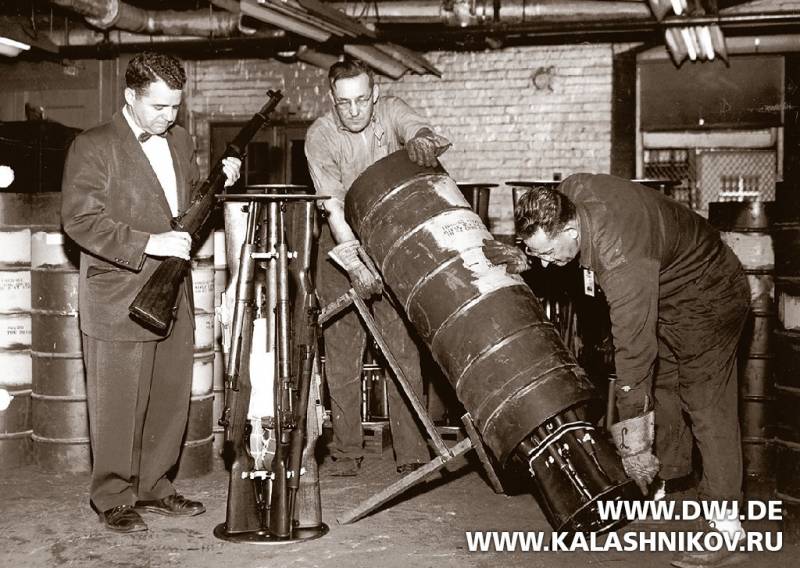
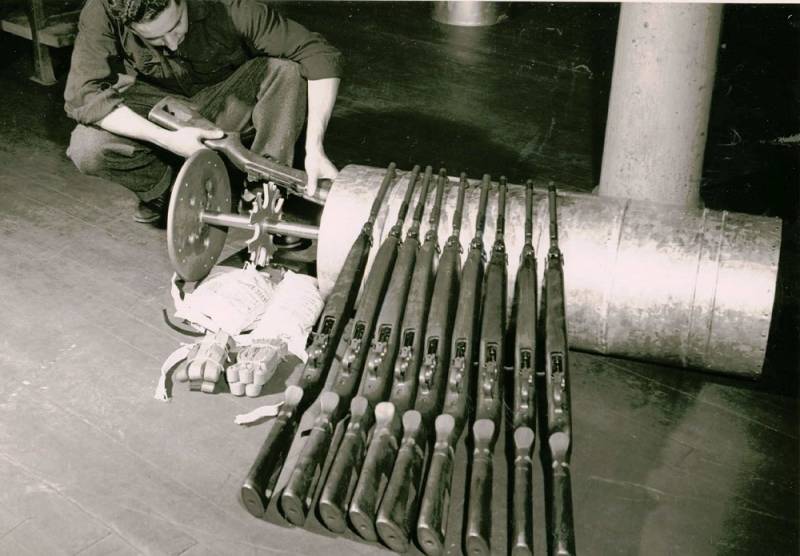
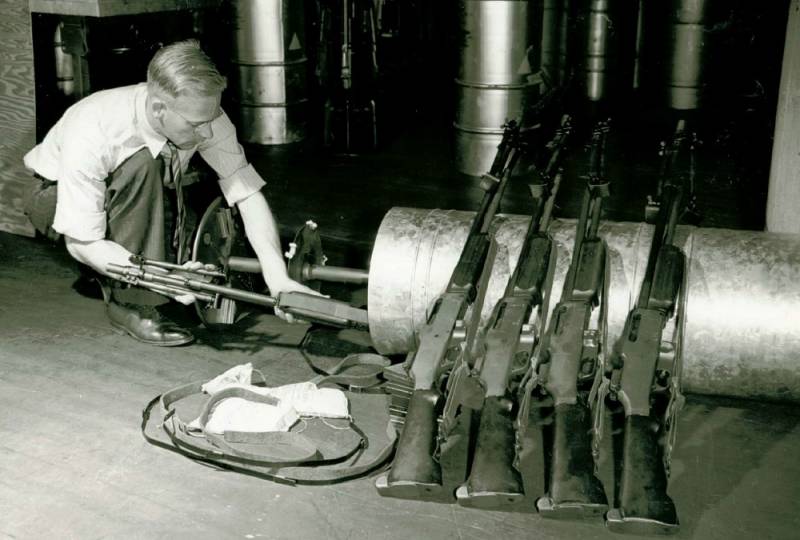
Information